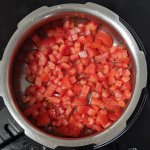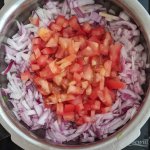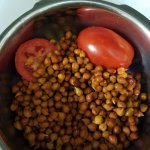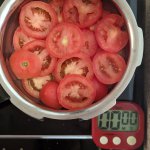Techniques – #T for Tomatoes





T is for Tomato hacks and more. T also serves as a placeholder for new techniques that might emerge in the future.
Tomato caramelisation is even more laborious than onion caramelisation. Tomatoes need various degrees of caramelisation and consistencies depending on the recipe they are used in. We started using tomatoes in different ways, depending on the desired output.
1a. Whole Tomatoes with oil bufferIn some recipes, tomatoes need to be thoroughly cooked with a roasted flavour. Consistency is not as important here as the flavour and ease of removal of skins/ seeds. In these cases, we started advocating the use of small, whole tomatoes.
b. Whole tomatoes with water buffer
In some recipes, tomatoes need to be thoroughly cooked, but without a roasted flavour. In these cases, we started advocating the use of small, whole tomatoes, with a water buffer.
2. Scooped tomatoes
When small tomatoes are not available, big tomatoes are used the same way. They were not used whole but were scooped out, to ensure heat is able to penetrate easily to the center.
3. Chopped Tomatoes (Deseeded/ not)
In layered recipes calling for a thick, puree, we started using de-seeded tomatoes as layer 2, usually with an oil buffer in layer 1. The oil buffer was used in recipes like Tomato thokku where caramelisation was mandatory. Non-de-seeded tomatoes with water buffer was used as layer 2 in recipes like Rasam, where caramelisation was not desired.
4. Chopped tomatoes with onions
In layered recipes calling for both caramelised onions and tomatoes, we started using chopped tomatoes along with onions as layer 2, usually with an oil buffer in layer 1. This layering was done two ways:
a. Half & Half
b. Bull’s eye
This arrangement was suitable when we had a pot in layer 3, pressing down on layer 2. As onions burn faster than tomatoes, and even faster if they are pressed down, they were relegated to the edges. In both these cases, tomatoes could either be used straight or de-seeded, depending on the moisture content of onions.
5. Tomatoes as PIP
We started using tomatoes as edible cups to hold various ingredients like GG paste, spice powders, eggs, coconut paste & nut pastes which would burn if they touched the base. On cooking, the cups disintegrated into the gravy. This technique also unlocked many soups including the South Indian favourite – the Rasam.
6. Tomatoes as a souring agent
In recipes tomatoes were used as a souring agent, caramelisation is not mandatory and they could be added to any layer, unlike onions which could only be used in Layer 2 and nowhere else.
